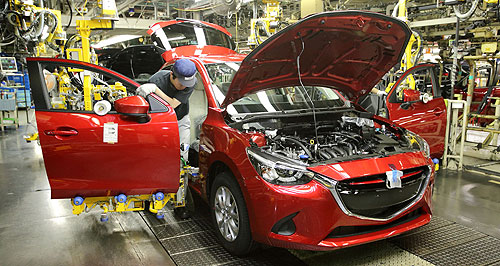Make / Model Search
News - MazdaMazda’s plans to split global production revealedDivide and conquer: Mazda will look to its overseas manufacturing sites to share the load. Plants in Mexico, Thailand to take capacity from increasingly busy Japanese sites19 Mar 2015 By TIM ROBSON MAZDA Australia executives have outlined a global plan that will spread the traditionally domestic-focussed Japanese company’s manufacturing footprint across the globe. The plan will see 50 per cent of Mazda’s total annual production – which reached 1,328,426 units globally in 2014 – divided between its Mexican and Thai plants, and the other 50 between its two Japanese plants, by 2020. Just over 394,100 passenger and commercial vehicles were manufactured outside Japan in 2014, with 934,000 units built on home soil. Speaking to GoAuto at the recent CX-3 launch in Canberra, Mazda Australia managing director Martin Benders outlined the plan to make better use of its resources around the globe. “The goal is to expand the global (production) footprint to make it 50 per cent inside and outside Japan,” Mr Benders told GoAuto. “There are the two Japanese plants in Hiroshima and Hofu, the AAT (AutoAlliance Thailand) plant in Thailand and the Mexican plant (Mazda de Mexico Vehicle Operation (MMVO) in Salamanca, which opened in January 2014). Currently, Mazda2 production swings between Japan and Thailand, and Mazda3 production swings between Japan and Mexico,” Mr Benders explained. “That way, they can manage production demand. “They will start to supply Europe with Mazda3 out of Mexico, as well.” He denied that there were any plans to build any SUV products outside of Japan, despite the fact that the forthcoming CX-9’s biggest market will be the North American continent, and the sheer volume of products coming through the Hiroshima plant. “All the SUVs are built in Hiroshima,” he stated. “There’s no plans to change that.” The Ujina, Hiroshima plant currently produces Mazda6, Premacy, MPV, CX-3, CX-9 and MX-5/Fiat 124 Spider. As a snapshot, it built 312,453 CX-5s in 2014, with more than 282,000 examples marked for export. Hofu builds the Mazda3. AutoAlliance Thailand builds Mazda’s BT-50 light-commercial ute and the Mazda2, while the new Mexican plant produces the Mazda3 for the American continent and, soon, Europe. Mazda Australia sources its cars from Hiroshima, Hofu and Thailand. Mazda2 supply was switched back to AAT in September 2014, after being sourced for a number of years from Japan.  Read more |
Click to shareMazda articlesResearch Mazda Motor industry news |












Facebook Twitter Instagram